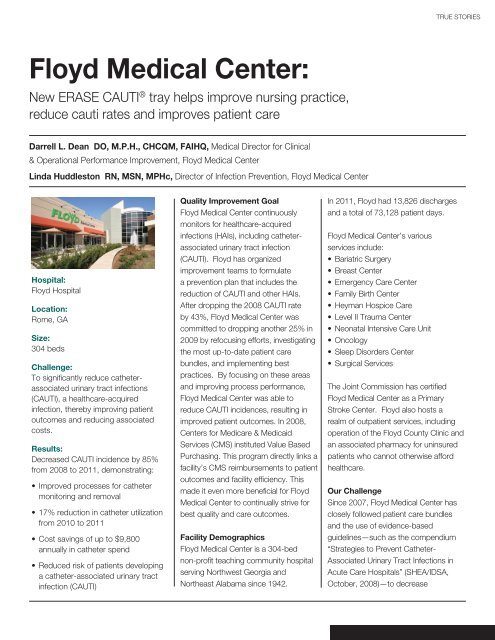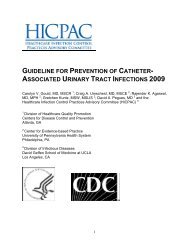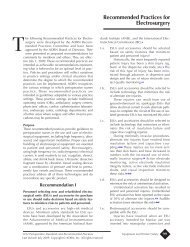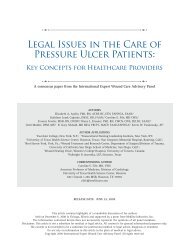Case Study: Floyd Medical Center - Medline
Case Study: Floyd Medical Center - Medline
Case Study: Floyd Medical Center - Medline
Create successful ePaper yourself
Turn your PDF publications into a flip-book with our unique Google optimized e-Paper software.
TRUE STORIES<br />
<strong>Floyd</strong> <strong>Medical</strong> <strong>Center</strong>:<br />
New ERASE CAUTI ® tray helps improve nursing practice,<br />
reduce cauti rates and improves patient care<br />
Darrell L. Dean DO, M.P.H., CHCQM, FAIHQ, <strong>Medical</strong> Director for Clinical<br />
& Operational Performance Improvement, <strong>Floyd</strong> <strong>Medical</strong> <strong>Center</strong><br />
Linda Huddleston RN, MSN, MPHc, Director of Infection Prevention, <strong>Floyd</strong> <strong>Medical</strong> <strong>Center</strong><br />
Hospital:<br />
<strong>Floyd</strong> Hospital<br />
Location:<br />
Rome, GA<br />
Size:<br />
304 beds<br />
Challenge:<br />
To significantly reduce catheterassociated<br />
urinary tract infections<br />
(CAUTI), a healthcare-acquired<br />
infection, thereby improving patient<br />
outcomes and reducing associated<br />
costs.<br />
Results:<br />
Decreased CAUTI incidence by 85%<br />
from 2008 to 2011, demonstrating:<br />
• Improved processes for catheter<br />
monitoring and removal<br />
• 17% reduction in catheter utilization<br />
from 2010 to 2011<br />
• Cost savings of up to $9,800<br />
annually in catheter spend<br />
• Reduced risk of patients developing<br />
a catheter-associated urinary tract<br />
infection (CAUTI)<br />
Quality Improvement Goal<br />
<strong>Floyd</strong> <strong>Medical</strong> <strong>Center</strong> continuously<br />
monitors for healthcare-acquired<br />
infections (HAIs), including catheterassociated<br />
urinary tract infection<br />
(CAUTI). <strong>Floyd</strong> has organized<br />
improvement teams to formulate<br />
a prevention plan that includes the<br />
reduction of CAUTI and other HAIs.<br />
After dropping the 2008 CAUTI rate<br />
by 43%, <strong>Floyd</strong> <strong>Medical</strong> <strong>Center</strong> was<br />
committed to dropping another 25% in<br />
2009 by refocusing efforts, investigating<br />
the most up-to-date patient care<br />
bundles, and implementing best<br />
practices. By focusing on these areas<br />
and improving process performance,<br />
<strong>Floyd</strong> <strong>Medical</strong> <strong>Center</strong> was able to<br />
reduce CAUTI incidences, resulting in<br />
improved patient outcomes. In 2008,<br />
<strong>Center</strong>s for Medicare & Medicaid<br />
Services (CMS) instituted Value Based<br />
Purchasing. This program directly links a<br />
facility’s CMS reimbursements to patient<br />
outcomes and facility efficiency. This<br />
made it even more beneficial for <strong>Floyd</strong><br />
<strong>Medical</strong> <strong>Center</strong> to continually strive for<br />
best quality and care outcomes.<br />
Facility Demographics<br />
<strong>Floyd</strong> <strong>Medical</strong> <strong>Center</strong> is a 304-bed<br />
non-profit teaching community hospital<br />
serving Northwest Georgia and<br />
Northeast Alabama since 1942.<br />
In 2011, <strong>Floyd</strong> had 13,826 discharges<br />
and a total of 73,128 patient days.<br />
<strong>Floyd</strong> <strong>Medical</strong> <strong>Center</strong>’s various<br />
services include:<br />
• Bariatric Surgery<br />
• Breast <strong>Center</strong><br />
• Emergency Care <strong>Center</strong><br />
• Family Birth <strong>Center</strong><br />
• Heyman Hospice Care<br />
• Level II Trauma <strong>Center</strong><br />
• Neonatal Intensive Care Unit<br />
• Oncology<br />
• Sleep Disorders <strong>Center</strong><br />
• Surgical Services<br />
The Joint Commission has certified<br />
<strong>Floyd</strong> <strong>Medical</strong> <strong>Center</strong> as a Primary<br />
Stroke <strong>Center</strong>. <strong>Floyd</strong> also hosts a<br />
realm of outpatient services, including<br />
operation of the <strong>Floyd</strong> County Clinic and<br />
an associated pharmacy for uninsured<br />
patients who cannot otherwise afford<br />
healthcare.<br />
Our Challenge<br />
Since 2007, <strong>Floyd</strong> <strong>Medical</strong> <strong>Center</strong> has<br />
closely followed patient care bundles<br />
and the use of evidence-based<br />
guidelines—such as the compendium<br />
“Strategies to Prevent Catheter-<br />
Associated Urinary Tract Infections in<br />
Acute Care Hospitals” (SHEA/IDSA,<br />
October, 2008)—to decrease
TRUE STORIES<br />
healthcare-associated infections (HAIs).<br />
Initiatives to reduce the incidence of<br />
HAIs are a priority for hospitals across<br />
the nation. As focus has intensified,<br />
hospitals have become the beneficiaries<br />
of focused research leading to widely<br />
accepted improvements. In 2007,<br />
<strong>Floyd</strong> attended VHA Georgia’s CEO<br />
Quality Summit, which focused in<br />
part on providing support to VHA<br />
members as they engaged their facility<br />
boards around quality metrics and<br />
initiatives. After attending this Quality<br />
Summit, we chose to pursue a goal of<br />
reducing HAIs. Our main goal was to<br />
reduce healthcare-acquired infections,<br />
to help improve nursing practice,<br />
patient outcomes and reduce costs.<br />
Specifically, our objective was to<br />
start by reducing catheter-associated<br />
urinary tract infections by 25% during<br />
calendar year 2009. Initial areas of<br />
improvements involved educational<br />
and surveillance efforts from infection<br />
preventionists; cooperative compliance<br />
from nursing staff; oversight by the<br />
Quality Improvement Department; and<br />
increased hand hygiene attention from<br />
all staff, visitors, and patients.<br />
While developing this prevention plan,<br />
we identified challenges in our practices<br />
relating to education; guidelines and<br />
protocol for catheter use, insertion,<br />
maintenance, and removal; and our<br />
monitoring and reporting structure.<br />
These issues were related to:<br />
• Need for proper documentation<br />
for insertion;<br />
• Variance in how and which nurses<br />
were performing insertion;<br />
• Product design limiting ability to<br />
maintain aseptic technique.<br />
“The revolutionary new tray design highlights proper techniques<br />
and encourages standardized practices for Foley catheters.”<br />
After identifying these challenges,<br />
<strong>Floyd</strong> <strong>Medical</strong> <strong>Center</strong> established the<br />
following goals:<br />
• Enhance nurse education;<br />
• Raise awareness of CAUTI<br />
prevention;<br />
• Reduce catheter utilization;<br />
• Reduce overall CAUTI rate.<br />
The Solution<br />
While we worked on identifying<br />
our reduction goals and how to<br />
achieve them to improve outcomes,<br />
we recognized that there were<br />
improvement opportunities in the<br />
catheter tray itself. Dr. Darrell Dean,<br />
our <strong>Medical</strong> Director for Clinical and<br />
Operational Performance Improvement,<br />
approached <strong>Medline</strong>, our medical<br />
supplier, about building a custom<br />
Foley tray. In turn, <strong>Medline</strong> asked Dr.<br />
Dean to participate in a focus group<br />
to help build a new standard “best<br />
practice” closed Foley catheter tray.<br />
Each focus group was supplied with<br />
the components of a catheter tray and<br />
asked to build their ideal. Once these<br />
ideals were created, each group gave<br />
a short presentation back to <strong>Medline</strong><br />
detailing the reasons behind every<br />
change or suggestion.<br />
In his assessment of the tray redesign,<br />
Dr. Dean delivered the <strong>Floyd</strong> <strong>Medical</strong><br />
<strong>Center</strong> staff concerns and supplied<br />
key suggestions including: hand<br />
sanitizer gel for continued hand hygiene<br />
compliance during insertion, and<br />
exchanging the forceps and cotton<br />
balls for Betadine ® swabs to limit<br />
cross-contamination when cleaning<br />
the patient.<br />
Dr. Dean’s recommendations and<br />
those of nurses, doctors, technicians,<br />
and infection preventionists from other<br />
facilities were included in <strong>Medline</strong>’s<br />
innovative new one-layer Foley catheter<br />
tray. Specific considerations were<br />
given to:<br />
1. Larger sterile barrier;<br />
2. Stickers on the tray label that<br />
can be placed in a patient<br />
record and provide a checklist for<br />
both valid clinical reasons to<br />
insert a catheter and proper<br />
catheter insertion procedures;<br />
3. Educational packaging with<br />
step-by-step pictorial instructions<br />
on the exterior of the kit increases<br />
efficiency and reduces<br />
contamination of the sterile field;<br />
4. Disposable Betadine swabs for<br />
cleansing, rather than forceps and<br />
cotton balls, thereby limiting<br />
cross-contamination;<br />
5. Hand sanitizer to encourage<br />
continued hand hygiene compliance<br />
during insertion.<br />
The revolutionary new tray design<br />
highlights proper techniques and<br />
encourages standardized practices for<br />
Foley catheters. The Foley InserTag ®<br />
also plays an important part as a daily<br />
reminder to consider removal or to<br />
document a reason for continued<br />
catheterization. Finally, the new design<br />
assisted staff in following the updated<br />
guidelines and recommendations<br />
that were becoming standard<br />
recommended practice in the industry.
Execution<br />
<strong>Floyd</strong> was proud to be one of the<br />
earliest adopters of <strong>Medline</strong>’s new<br />
ERASE CAUTI one-layer closed<br />
Foley catheter tray, and the tray was<br />
immediately rolled out hospital-wide<br />
to very positive feedback.<br />
Education was the first portion of<br />
success realized by implementing<br />
these trays. <strong>Medline</strong>’s education<br />
raised awareness among our staff of<br />
the true mortality risks of CAUTI. This<br />
awareness helped remind clinicians<br />
why it was not always necessary or<br />
recommended to insert a catheter.<br />
The patient and family education card<br />
included in the tray—designed to look<br />
like a greeting card—was also wellreceived,<br />
not only by the patients and<br />
families, but also by the staff, who<br />
nominated the piece as one of their top<br />
five features of the ERASE CAUTI tray.<br />
<strong>Floyd</strong> continues education by<br />
covering proper insertion guidelines<br />
and technique during new hire<br />
orientation, and further reviews these<br />
issues for all staff members during<br />
annual competencies. We plan to<br />
integrate <strong>Medline</strong>’s interactive ERASE<br />
CAUTI competency education—<br />
available on <strong>Medline</strong> University<br />
(www.medlineuniversity.com) to ERASE<br />
CAUTI program members—into our<br />
own e-learning provider in 2012.<br />
The checklist sticker located on the<br />
front of the tray and the Foley InserTag ®<br />
contained within guide staff to adhere<br />
to a proper documentation process<br />
if they must insert a catheter, and<br />
provide timely reminders to remove<br />
the catheter. Clinicians value this<br />
quick, easy reminder provided by<br />
the InserTag, a faster reminder than<br />
searching each patient’s chart for<br />
catheter insertion date and time.<br />
These additions to the tray also<br />
best addressed our initially identified<br />
challenge of too many Foley catheters<br />
inserted, and too many left in longer<br />
than recommended or necessary.<br />
We were most appreciative, however,<br />
of <strong>Medline</strong>’s invitation to members of<br />
our facility to give input on an ideal best<br />
practice tray, then actually designing<br />
a tray that met those needs. Knowing<br />
that our needs were not unique to our<br />
facility, it was encouraging to know that<br />
our input and the input of others would<br />
help the medical community realize<br />
similar positive outcomes.<br />
Results<br />
<strong>Floyd</strong> <strong>Medical</strong> <strong>Center</strong> was pleased with<br />
the results realized year over year in the<br />
partnership with <strong>Medline</strong>’s ERASE<br />
CAUTI closed Foley catheter trays.<br />
By the end of 2008, CAUTI rates had<br />
dropped 43%. Rates dropped again<br />
from 2008 to 2009—realizing a savings<br />
of $5,400—and the overall drop from<br />
2008 to 2011 currently stands at 85%.<br />
Catheter utilization decreased as well,<br />
boasting a 17% reduction from 2010<br />
to 2011, and a spend reduction of<br />
$9,800.<br />
<strong>Floyd</strong> <strong>Medical</strong> <strong>Center</strong> continues to train<br />
staff members annually, believing that<br />
ongoing awareness is imperative to<br />
improving quality of care. As a result,<br />
CAUTI rates have remained low. In<br />
recognition of its accomplishments,<br />
<strong>Floyd</strong> earned first place in VHA<br />
Georgia’s 2010 Clinical Excellence<br />
award category, a peer reviewed<br />
award process focusing on operational,<br />
clinical, and supply chain excellence.
TRUE STORIES<br />
Summary of Clinical Outcomes<br />
• Increased nurse/physician<br />
communication and documentation<br />
• Increased overall awareness of<br />
proper indications for catheter usage<br />
• 85% drop in CAUTI rates<br />
• 37% drop in number of catheter days<br />
• 17% reduction in catheter utilization<br />
from 2010 to 2011<br />
• Significant cost savings for <strong>Floyd</strong><br />
<strong>Medical</strong> <strong>Center</strong><br />
These outcomes were made possible<br />
by <strong>Medline</strong>’s innovative ERASE CAUTI<br />
one-layer closed Foley catheter tray.<br />
Combining the tray with continuous<br />
training and awareness has resulted<br />
in a reduction in variation of practice<br />
and outcomes that continually trend<br />
downward.<br />
“Combining the tray with continuous training and awareness has<br />
resulted in a reduction in variation of practice and outcomes that<br />
continually trend downward.”<br />
insertion, monitoring, and removal,<br />
thereby reducing the risk of CAUTI<br />
and presenting a better patient<br />
experience. Through the work of front<br />
line nurses and therapists, continued<br />
training, and use of the ERASE CAUTI<br />
tray, <strong>Floyd</strong> has been able to bring<br />
our improvements to the patients’<br />
bedsides, enhance the culture of safety,<br />
and continue the quality initiatives that<br />
have made a difference in the lives of<br />
our patients and the community<br />
at large.<br />
As a result, <strong>Floyd</strong> <strong>Medical</strong> <strong>Center</strong> has<br />
improved processes for catheter<br />
About the Authors<br />
Darrell Dean, DO, M.P.H., CHCQM, FAIHQ, is the <strong>Medical</strong> Director for Clinical and Operational Performance<br />
Improvement at <strong>Floyd</strong> <strong>Medical</strong> <strong>Center</strong>. He is also the CME Surveyor for ACCME accreditation of hospitals for<br />
the <strong>Medical</strong> Association of Georgia. Prior to his current position, Darrell was Internal Consultant for coding and<br />
documentation for Centrex Primary Care Network. He was also Associate <strong>Medical</strong> Director of Network Staff<br />
Physician, North Georgia <strong>Medical</strong> Associates and served as locum tenens for all 17 practice sites. He has also<br />
worked at the Georgia Department of Human Resources, Division of Public Health as the District <strong>Medical</strong> Director,<br />
Coosa Valley Health District. Darrell received his Master of Public Health degree, Health Policy and Administration Track from<br />
Emory University, Rollins School of Public Health.<br />
Linda Huddleston, RN, MSN, MPHc, Director of Infection Prevention at <strong>Floyd</strong> <strong>Medical</strong> <strong>Center</strong>, has been a<br />
nurse for 34 years and an infection preventionist for three years. Linda is a past president of the APIC Greater<br />
Chattanooga chapter and the secretary for the Georgia Organization of Nurse Leaders. She leads many teams<br />
at <strong>Floyd</strong>, two of which continually work to decrease both CLABSI and CAUTI. As a result, <strong>Floyd</strong> won<br />
two VHA awards in 2011 related to decreasing CLABSIs and two awards in 2010 for decreasing CAUTIs.<br />
Linda remains on the cutting edge of moving teams forward with new guidelines and regulations.<br />
©2012 <strong>Medline</strong> and Foley InserTag are registered trademarks of <strong>Medline</strong> Industries, Inc.<br />
Betadine is a registered trademark of Purdue Products L.P.<br />
MKT1217748 / LIT040 / 2M / DLP5

















